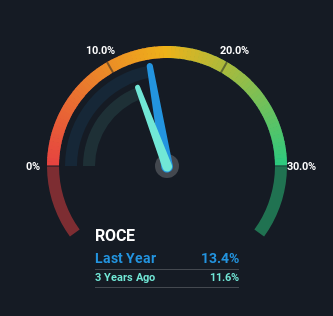- United States
- /
- Household Products
- /
- NasdaqGS:REYN
Reynolds Consumer Products (NASDAQ:REYN) Has More To Do To Multiply In Value Going Forward

Did you know there are some financial metrics that can provide clues of a potential multi-bagger? Typically, we'll want to notice a trend of growing return on capital employed (ROCE) and alongside that, an expanding base of capital employed. Put simply, these types of businesses are compounding machines, meaning they are continually reinvesting their earnings at ever-higher rates of return. Although, when we looked at Reynolds Consumer Products (NASDAQ:REYN), it didn't seem to tick all of these boxes.
Understanding Return On Capital Employed (ROCE)
If you haven't worked with ROCE before, it measures the 'return' (pre-tax profit) a company generates from capital employed in its business. The formula for this calculation on Reynolds Consumer Products is:
Return on Capital Employed = Earnings Before Interest and Tax (EBIT) ÷ (Total Assets - Current Liabilities)
0.13 = US$575m ÷ (US$4.8b - US$543m) (Based on the trailing twelve months to September 2024).
Therefore, Reynolds Consumer Products has an ROCE of 13%. In absolute terms, that's a pretty normal return, and it's somewhat close to the Household Products industry average of 17%.
See our latest analysis for Reynolds Consumer Products

Above you can see how the current ROCE for Reynolds Consumer Products compares to its prior returns on capital, but there's only so much you can tell from the past. If you're interested, you can view the analysts predictions in our free analyst report for Reynolds Consumer Products .
What Can We Tell From Reynolds Consumer Products' ROCE Trend?
Over the past five years, Reynolds Consumer Products' ROCE and capital employed have both remained mostly flat. Businesses with these traits tend to be mature and steady operations because they're past the growth phase. With that in mind, unless investment picks up again in the future, we wouldn't expect Reynolds Consumer Products to be a multi-bagger going forward. This probably explains why Reynolds Consumer Products is paying out 54% of its income to shareholders in the form of dividends. Given the business isn't reinvesting in itself, it makes sense to distribute a portion of earnings among shareholders.
Our Take On Reynolds Consumer Products' ROCE
In summary, Reynolds Consumer Products isn't compounding its earnings but is generating stable returns on the same amount of capital employed. Additionally, the stock's total return to shareholders over the last three years has been flat, which isn't too surprising. All in all, the inherent trends aren't typical of multi-baggers, so if that's what you're after, we think you might have more luck elsewhere.
Like most companies, Reynolds Consumer Products does come with some risks, and we've found 2 warning signs that you should be aware of.
While Reynolds Consumer Products may not currently earn the highest returns, we've compiled a list of companies that currently earn more than 25% return on equity. Check out this free list here.
New: AI Stock Screener & Alerts
Our new AI Stock Screener scans the market every day to uncover opportunities.
• Dividend Powerhouses (3%+ Yield)
• Undervalued Small Caps with Insider Buying
• High growth Tech and AI Companies
Or build your own from over 50 metrics.
Have feedback on this article? Concerned about the content? Get in touch with us directly. Alternatively, email editorial-team (at) simplywallst.com.
This article by Simply Wall St is general in nature. We provide commentary based on historical data and analyst forecasts only using an unbiased methodology and our articles are not intended to be financial advice. It does not constitute a recommendation to buy or sell any stock, and does not take account of your objectives, or your financial situation. We aim to bring you long-term focused analysis driven by fundamental data. Note that our analysis may not factor in the latest price-sensitive company announcements or qualitative material. Simply Wall St has no position in any stocks mentioned.
About NasdaqGS:REYN
Reynolds Consumer Products
Produces and sells products in cooking, waste and storage, and tableware product categories in the United States and internationally.
Undervalued with proven track record.
Similar Companies
Market Insights
Community Narratives



